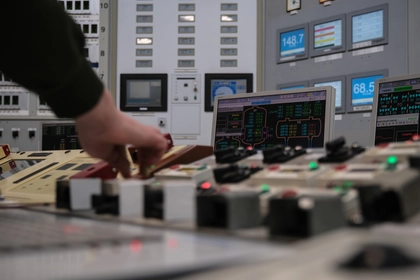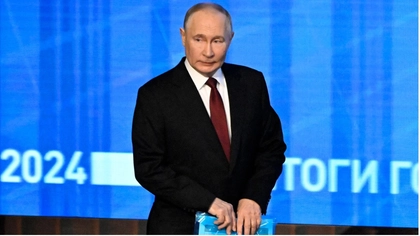Ukraine has lost half of its remaining power generation capability since March this year, Volodymyr Kudrytskyi, CEO of Ukrenergo, Ukraine’s state-owned transmission operator said.
“Nine gigawatts (GW) is a huge number,” said Kudrytskyi at a discussion panel hosted by Ukraine Business News (UBN) Network on Friday, June 21.
JOIN US ON TELEGRAM
Follow our coverage of the war on the @Kyivpost_official.
If Kudrytskyi’s figures are accurate, it would mean that Ukraine only had approximately 18 GW remaining in the system prior to the renewed Russian strikes this year – less than a third of its pre-war 56 GW figure.
And the energy deficit was felt by all those who attended the UBN event – it was interrupted multiple times because of Ukraine’s rolling blackouts.
At the discussion, Kudrytskyi, alongside Dmytro Sakharuk , Executive Director of Ukraine’s DTEK energy enterprise’s and former Deputy Minister of Energy Oleksiy Ryabchyn, the grim prospect of Ukraine’s energy situation and the dilemmas it’s facing was raised.
“Even in the summer, when we have 40 to 45 percent lower consumption than in winter, we have a deficit of power that cannot be covered by imports of electricity from Europe,” Kudrytskyi said, adding that a number of EU nations are now transferring 1.7 GW of energy to Ukraine to help cope with the deficit.
However, in answer to a later Kyiv Post question, Kudrytskyi declined to comment on the power capacity used last winter and needed for this upcoming winter, calling it a sensitive figure.

PICTURES: Kyiv in the Wake of Russia’s Devastating Missile Attack
DTEK’s Sakharuk named a deficit in air defense missiles as the main reason for Ukraine’s dwindling energy situation.
“It appears that for every missile that we have right now, five, six Russian missiles are coming in.
“If 10 missiles are coming in, you need at least 12 missiles in the air defense… so, even if we start recovering, start repairing, there’s no means right now to protect [the] recovered units,” Sakharuk said.
One of the energy experts present also criticized Kyiv’s lack of funding for the private sector and inadequate governance, which exacerbated the situation.
“In Ukraine, there is no capital in private hands. The capital only goes through government to government. [The] private sector is zero right now,” he said, adding that it would need close to $1 billion to restore a single GW of energy, regardless of the sources of energy.
“The state sector could not deliver results quickly in time, except [for a] few exceptions. We have some. But in general, it’s just total managerial inability to do something in time,” he added.
“Just because the money that was given to some state-owned companies will not be spent. Why? Because there is no organizational ability to spend them. No experience, no knowledge and no desire.”
Then there’s also the issue of war insurance – or the lack thereof – that prevented private companies such as DTEK from implementing some projects.
“It’s impossible to build something if you don’t have war insurance right now – or if you have, as everybody says, the coverage available [is] $1 million. But you need $1 billion… This is the third year we are talking about this,” Sakharuk said.
There are multiple ways to cope with the deficit – decentralized power generation, restoration of destroyed facilities, and importing more from Europe, all of which come with their own set of issues.
“We have to recover as much generation capability as possible before winter; We have to ask for extra air defense to protect what we recover, but also we have to roll out new generation facilities to make sure that if Russians undertake these attacks, they cannot concentrate on 10 or 15 big power plants, but they would have to deal with hundreds of smaller ones.
“This is what we talk about. This is where we get to [the] decentralization of the generation. And we have to do it not after the victory, not after the war, but right now,” said Ukrenergo’s Kudrytskyi.
He said Ukraine would need at least a few GWs to substitute for the ones Ukraine has lost, but still, the country “would not be able to recover in the next two to three years.”
As for decentralization, Kudrytskyi said a change of government approach is needed.
“And I agree with Dmytro. You cannot roll out decentralized generation in a centralized way,” he said, adding that it would not be possible to manage 500 smaller power plants through centralized governmental entities.
“With all due respect – not only are we talking about DTEK, we’re talking about 50 companies that should enter the market and more,” said Kudrytskyi.
Governance aside, it’s also believed that building new, decentralized facilities would take years – a long-term solution, but one that wouldn’t be able to remedy Ukraine’s situation this winter.
In terms of restoring current facilities, Sakharuk said DTEK plans to restore up to 50 percent of what it had before the Russian strikes on March 22 – up to 3 GW – but only if it’s protected.
In terms of electricity imports, Kudrytskyi said the best-case scenario would be to increase them to 2.2 GW, but it comes with technical and physical limitations.
“First of all, technically, there are limitations. There are physical limitations to push through the power from Europe to Ukraine. If you need extra GWs of imports, you need to build transmission lines. And it takes years, if not decades, in Europe to obtain needed permits, licenses to pass through certain communities and land,” he said.
At the end of the discussion, all three panel speakers agreed that it would be impossible to forecast the hours of electricity available per day this winter.
“I’m not a voodoo magician, the range of possibilities is quite high … It will almost fully depend on the attacks,” said Kudrytskyi.
You can also highlight the text and press Ctrl + Enter






